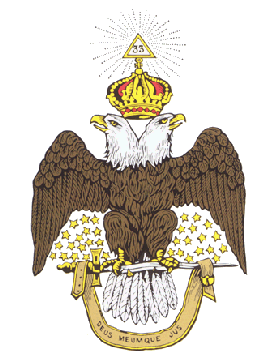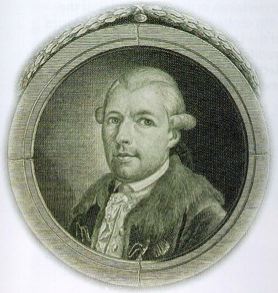
Freemasonry or simply Masonry includes various fraternal organisations that trace their origins to the local guilds of stonemasons that, from the end of the 14th century, regulated the qualifications of stonemasons and their interaction with authorities and clients. Freemasonry is the oldest fraternity in the world and among the oldest continued organizations in history.

The Ancient and Accepted Scottish Rite of Freemasonry is a rite within the broader context of Freemasonry. It is the most widely practiced Rite in the world. In some parts of the world, and in the Droit Humain, it is a concordant body and oversees all degrees from the 1st to 33rd degrees, while in other areas, a Supreme Council oversees the 4th to 33rd degrees.

The Knights Templar, full name The United Religious, Military and Masonic Orders of the Temple and of St John of Jerusalem, Palestine, Rhodes and Malta, is a fraternal order affiliated with Freemasonry. Unlike the initial degrees conferred in a regular Masonic Lodge, which only require a belief in a Supreme Being regardless of religious affiliation, the Knights Templar is one of several additional Masonic Orders in which membership is open only to Freemasons who profess a belief in Christianity. One of the obligations entrants to the order are required to declare is to protect and defend the Christian faith. The word "United" in its full title indicates that more than one historical tradition and more than one actual order are jointly controlled within this system. The individual orders 'united' within this system are principally the Knights of the Temple, the Knights of Malta, the Knights of St Paul, and only within the York Rite, the Knights of the Red Cross.

There are many organisations and orders which form part of the widespread fraternity of Freemasonry, each having its own structure and terminology. Collectively these may be referred to as Masonic bodies, Masonic orders, Concordant bodies or appendant bodies of Freemasonry.

The Illuminati is a name given to several groups, both real and fictitious. Historically, the name usually refers to the Bavarian Illuminati, an Enlightenment-era secret society founded on 1 May 1776 in the Electorate of Bavaria. The society's stated goals were to oppose superstition, obscurantism, religious influence over public life, and abuses of state power. "The order of the day," they wrote in their general statutes, "is to put an end to the machinations of the purveyors of injustice, to control them without dominating them." The Illuminati—along with Freemasonry and other secret societies—were outlawed through edict by Charles Theodore, Elector of Bavaria, with the encouragement of the Catholic Church, in 1784, 1785, 1787 and 1790. During subsequent years, the group was generally vilified by conservative and religious critics who claimed that the Illuminati continued underground and were responsible for the French Revolution.

The Rectified Scottish Rite (RER), also known as the Rectified Rite or RSR, is a Christian Masonic rite with a long and complex history. It was founded in 1778 at the Convent of Lyon in France under the leadership of Jean-Baptiste Willermoz, who served as the primary architect and driving force behind its formation. It emerged as a reform and restructuring of the earlier Templar Strict Observance system that had spread in Germany and France in the mid-18th century.

The French Rite is one of the oldest masonic rites, and the most widely practiced in France and Belgium. It is the direct heir and one of the best preserved ritual of speculative masonry as practiced by the Premier Grand Lodge of London in the early 18th century. Today, it is primarily practiced by over 900 lodges of the Grand Orient de France and by the Grande Loge Nationale Française, making it the predominant rite in France, it is also worked in several other masonic jurisdictions worldwide.
Freemasonry in France has been influential on the worldwide Masonic movement due to its founding of Continental Freemasonry.
The history of Freemasonry in Belgium reflects the many influences on what is now Belgium from the neighbouring states.
The Primitive Scottish Rite is a Masonic Rite. According to Robert Ambelain, an esotericist who "awakened" it in 1985, it was the rite used by the St. John of Scotland Lodge in Marseille, which was introduced to France in Saint-Germain-en-Laye from 1688; these claims are disputed by historians.

Jean-Baptiste Willermoz was a French Freemason and Martinist who played an important role in the establishment of various systems of Masonic high-degrees in his time in both France and Germany.

Jean-Marie Ragon de Bettignies was a Freemason, author and editor.

In Freemasonry, the first three Masonic degrees constitute the fundamental degrees in all Rites they are called Blue Lodge of Craft degree.
Masonic myths occupy a central place in Freemasonry. Derived from founding texts or various biblical legends, they are present in all Masonic rites and ranks. Using conceptual parables, they can serve Freemasons as sources of knowledge and reflection, where history often vies with fiction. They revolve mainly around the legendary stories of the construction of Solomon's temple, the death of its architect Hiram, and chivalry. Some of the original mythical themes are still part, to a greater or lesser extent and explicitly, of the symbols that make up the corpus and history of speculative Freemasonry. Some myths, however, have had no real posterity, but can still be found in some high grades, or in the symbolism of some rituals. Others borrow from the medieval imagination or from religious mysticism, and do not bother with historical truths to create legendary filiations with vanished guilds or orders.
The Philosophical Scottish Rite is a Masonic rite that was established in Paris in 1776 by the hermetist Alexandre Boileau, who was a disciple of Antoine-Joseph Pernéty. This rite is known for its unique structure and progression through various degrees.
Le Rite Primitif de Narbonne or Rite Primitif des Philadelphes, is a Masonic rite that was introduced in 1759, brought from Prague by Vicomte de Chefdebien d'Aigrefeuille.
The Rite des philalèthes(Rite of the Philalethes) comes from, Philalèthes or philalètes, which translates to: friend or seeker of truth, from the Greek Philos, friend and alètheia, truth, is in freemasonry, the name given to the Rite of the Philalethes and its practitioners. This system of philosophical or mystical Freemasonry was founded in 1773 by Marquis Charles-Pierre-Paul Savalette de Langes within the Masonic lodge "Les Amis réunis", of which he was the worshipful master and a founding member. This rite continued until the death of its founder in 1797.
The Orders of Wisdom is the contemporary designation for the high Masonic degrees of the French Rite. Originally designated as Ordres supérieurs, they were published in 1801 in a compendium entitled Le Régulateur des Chevaliers maçonsor Les Quatre ordres supérieurs, according to the regimen of the Grand Orient. The Orders of Wisdom were codified by the Chamber of Grades and the Grand Chapter General of France between 1783 and 1785 under the impetus of Alexandre Roëttiers de Montaleau, and subsequently integrated into the Grand Orient de France (GODF) on February 17, 1786. The rituals of the Orders of Wisdom continue the degree of "master", extending and deepening a symbolic and initiatory journey that commenced in the "blue lodge." The Orders of Wisdom were originally divided into four initiatory and philosophical orders and a fifth administrative and conservatory order.










